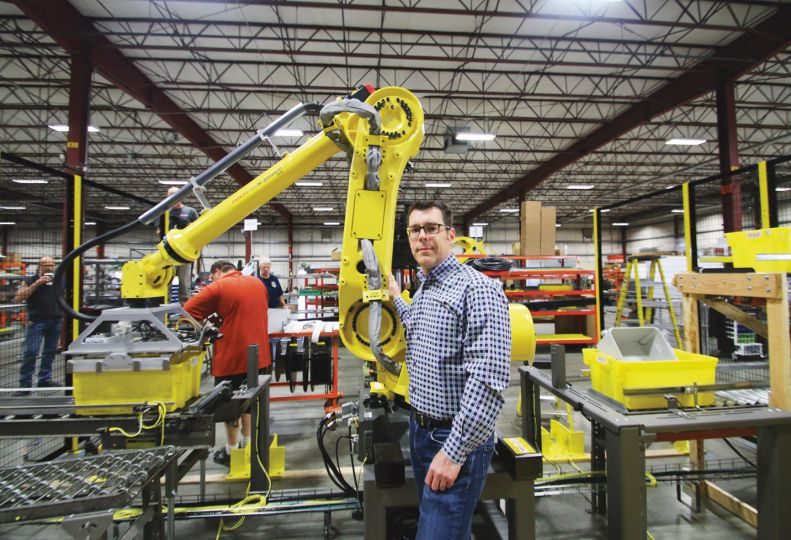
Home » Pearson Packaging's growth wave
Pearson Packaging's growth wave
Company plans to add more workers to operation here

May 19, 2016
Pearson Packaging Systems, the West Plains-based maker of packaging equipment, says it expects double-digit revenue growth this year and for the foreseeable future.
President and CEO Michael A. Senske says the company has experienced that sustained level of growth every year for the last eight years. He declines to disclose specific figures, but says for 2016, “We’re anticipating between 15 to 17 percent growth in revenue.”
Senske says Pearson, which has acquired two packaging industry companies over the last eight years, is exploring other acquisitions, but declines to provide additional details.
According to the last financial information Pearson provided to the Journal, which was for a list published in the May 24, 2012, edition, company sales in 2011 were $41.2 million, up from $33.7 million in 2010.
Located at 8120 W. Sunset Highway, Pearson expects to hire up to four new control engineers at its packaging equipment plant here. Meanwhile, as many as six mechanical engineers could be hired at a facility it operates in Vernon, Ill., near Chicago, he says.
Pearson now has an employee roster of 200 workers, up from 134 at the beginning of 2011.
Roughly 150 employees are based at Pearson’s 110,000-square-foot manufacturing and assembly operations facility on the West Plains. The company employed approximately 100 workers at its Spokane operation in 2011.
Its Chicago-area location has 25 employees, while 15 regional service technicians and 10 regional sales managers are located across North America, Senske says.
Pearson builds machines that erect boxes and pack, seal, and palletize products. It sells its equipment worldwide to manufacturers of food, beverage, and personal-care products, including big customers such as Hostess Brands LLC, the J.M. Smucker Co., and Kraft Foods Inc.
Just over half the company’s machinery is purchased by food companies. Senske says the rest is broken down as such: 20 percent beverage; 11 percent household, chemicals and personal care; 9 percent consumer durable goods; 5 percent warehouse automation; and 3 percent to miscellaneous industries.
“It’s important to note that through continuous improvement using Kaizen—the practice of continual improvement—and (another process-improvement approach called) Six Sigma, we have doubled revenue with roughly the same number of employees,” he says.
Pearson now has more than 19,000 machines deployed around the world, the company’s website says.
In December, the company hired Ryan McCart as vice president of a new business unit called the Systems Solutions Group, which is dedicated to complex integrated systems. Since 2002, Pearson has moved from exclusively building machines to providing complete end-of-line systems.
Pearson Packaging was formed in 1955 as R.A. Pearson Co. by R.A. “Lefty” Pearson, who was the bottle shop superintendent for Spokane’s Bohemian Brewery. He owned and managed the company until his death in 1971.
Pearson’s widow, Alma Pearson, served as president from 1983 until 1992, and her daughter, Pam Senske, held the top spot until her son, Michael, took over in 2003. R.A. Pearson Co. changed its name to Pearson Packaging Systems in 2002.
Four years ago, Pearson bought Moen Industries, a Los Angeles-based producer of packaging equipment and corrugated packaging designs. Before that, in 2008, Pearson bought Goodman Packaging Equipment, roughly 40 miles northwest of downtown Chicago.
A more recent growth catalyst, Senske says, occurred about two years ago when Pearson began studying user-centric design to understand how people use and interact with machines. It led to a company decision to equip its machines with more sophisticated touchscreen technology developed by Rockwell Automation Inc., based in Milwaukee.
It previously used less sophisticated touchscreens that were harder to read, lacked color and were smaller in size.
Of Rockwell Automation, Senske says, “We utilize their human-machine interface software development environment and then create what you see on the screen using their software.”
Pearson also hired an engineer with a degree from the University of Washington’s Human Centered Design & Engineering department to spearhead the company’s efforts to advance its user-centric design initiative.
Leo Robertson, the vice president of engineering, says in a video on Pearson’s website, “User-centric design at this point has really become a part of our culture. It’s an ongoing process that affects new machine design and product life-cycle management. It’s a different way of looking at producing equipment.”
Senske says the proliferation of consumer electronics through phones and tablets has changed the expectations of manufacturing companies and their customers.
Senske says the Rockwell Automation touchscreens are more colorful and easier to read, have improved graphics, employ more icons and use less text than earlier versions of screens, in an effort to reduce language challenge for non-English speaking customers.
“The feedback we’ve received from our customers about the touchscreens has been more favorable than anything I’ve ever experienced in the 17 years I’ve been here,” he says.
By studying and employing user-centric design, Senske says Pearson representatives now can observe how its customers are using touchscreens and can continue to more effectively improve them.
“We’ve been able to dramatically modernize a component of the manufacturing industry that’s really been slow to evolve,” Senske says. “By making the software simpler and the interface easier to use, businesses don’t have to spend as much time on training workers to use them.”
The implementation of user-centric design is still in the infant stages, and Pearson is still in the process of more precisely quantifying the benefits of the technology for itself as well as for its customers, Senske says.
Latest News Special Report Manufacturing
Related Articles
Related Products



![Brad head shot[1] web](https://www.spokanejournal.com/ext/resources/2025/03/10/thumb/Brad-Head-Shot[1]_web.jpg?1741642753)
